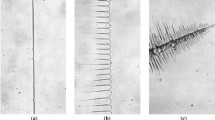Abstract
The purification of tin by a zone refining method has been examined both theoretically and experimentally. A model capable of simulating the characteristics of zone refining was proposed by taking account of the solute transport resistance in the melt. The effective distribution coefficient could be expressed in terms of the parameterD/v, zone length, and the equilibrium distribution coefficient. It appears that for large values of the zone travel rate and zone length, zone refining does not result in satisfactory purification even by repeated-pass methods. Experimental results indicated that the concentration distribution of lead and bismuth was in good agreement with that estimated by the proposed model. Diffusivities of lead and bismuth in the tin melt at a slightly higher temperature than the melting point, 505 K, could be estimated to be 4.5 × 10−5 cm−5/s and 5.5 × 10−5 cm2/s, respectively. Such large values should be substantially ascribed to enhancement of solute transport due to natural convection.
Similar content being viewed by others
References
T. S. Mackey:J. Met., 1982, vol. 34, pp. 72–76.
P. A. Wright:Extractive Metallurgy of Tin, Elsevier Publishing Co., Amsterdam, 1966, pp. 110–62.
H. F. Van Wijk, P. F. J. Van Most, and W. M. Smit:Analy. Chim. Acta, 1967, vol. 38, pp. 285–90.
M. Tanenbaum, A. J. Goss, and W. G. Pfann:J. Met., 1954, vol. 200, pp. 762–63.
N. T. G. Bollen, M. J. Van Essen, and W. M. Smit:Analy. Chim. Acta, 1967, vol. 38, pp. 279–84.
Y. Hoshino and T. Utsinomiya:Sep. Sci. TechnoL, 1980, vol. 15, pp. 1521–31.
J. A. Burton, R. C. Prim, and W. P. Slichter:J. Chem. Phys., 1953, vol. 21, pp. 1987–1991.
W. G. Pfann:J. Met., 1952, vol. 194, pp. 747–53.
N. W. Lord:J. Met., 1953, vol. 197, pp. 1531–33.
L. Burns, C.H. Stockman, and I. G. Dillon:J. Met., 1955, vol. 203, pp. 1017–23.
B. V. Ramarao and W. R. Wilcox:J. Cryst. Growth, 1982, vol. 59, pp. 557–62.
Kirk-Othmer Encyclopedia of Chemical Technology, 3rd ed., John Wiley & Sons, New York, NY, 1984, pp. 903–17.
J. M. Lommel and B. Chalmers:Trans. TMS-AIME, 1959, vol. 215, pp. 499–508.
S. J. Rothman and L. D. Hall:J. Met., 1956, vol. 206, pp. 199–203.
S. J. Rothman and L. D. Hall:J. Met., 1956, vol. 207, p. 1580.
Author information
Authors and Affiliations
Rights and permissions
About this article
Cite this article
Lee, H.Y., Oh, J.K. & Lee, D.H. Purification of tin by zone refining with development of a new model. Metall Trans B 21, 455–461 (1990). https://doi.org/10.1007/BF02667857
Received:
Issue Date:
DOI: https://doi.org/10.1007/BF02667857




